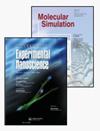铁纳米线的氢脆:研究尺寸和取向对加载行为的依赖
IF 2
4区 化学
Q4 CHEMISTRY, PHYSICAL
引用次数: 0
摘要
摘要随着纳米线的使用和应用的不断增加,了解环境相互作用如何改变纳米线独特的机械性能和负载行为变得前所未有的迫切。虽然实验研究表明,原子氢通过氢脆降低机械性能,但结果是有限的,通常没有直接量化氢浓度或考虑小直径纳米线。在本研究中,我们利用分子动力学模拟研究了原子氢对不同取向和直径的铁纳米线的影响。结果表明,与考虑的所有直径和方向的无氢情况相比,随着氢浓度的增加,弹性模量和屈服应力明显降低。此外,这种机械性能的降低似乎与尺寸有关,在横截面直径较大的纳米线中发现了更大的降低。我们认为,较小直径的纳米线,具有较高的表面原子与体原子的比例,受自由表面原子的影响比氢原子的晶格畸变更大。随着表面原子与体积原子的比例降低,直径较大的纳米线受自由表面的影响较小,更容易受到氢原子的影响。关键词:纳米线氢脆弹性模量Morrissey要感谢加拿大国家科学与工程研究委员会通过发现基金对这项研究的支持。披露声明作者未报告潜在的利益冲突。本研究得到了加拿大自然科学与工程研究委员会的支持。本文章由计算机程序翻译,如有差异,请以英文原文为准。
Hydrogen embrittlement of iron nanowires: investigating size and orientation dependence on loading behaviour
ABSTRACTWith the ever-increasing use and applications of nanowires it has never been more imperative to understand how environmental interactions modify their unique mechanical properties and loading behaviour. While experimental research has shown that atomic hydrogen degrades mechanical properties through hydrogen embrittlement, results are limited and often do not directly quantify the hydrogen concentration or consider small diameter nanowires. In this study, we have used molecular dynamics simulations to the study the effect of atomic hydrogen on iron nanowires with various orientations and diameters. Results demonstrate that with increasing hydrogen concentration there is a clear reduction in the elastic modulus and yield stress as compared to the hydrogen free case for all diameters and orientations considered. In addition, this reduction in mechanical properties appears to exhibit a size dependence, with larger reductions being found in nanowires with larger cross-sectional diameters. We suggest that smaller diameter nanowires, with a higher ratio of surface to bulk atoms, are more influenced by free surface atoms than lattice distortions from atomic hydrogen. As this ratio of surface to bulk atoms is decreased, the larger diameter nanowires become less affected by free surfaces and more susceptible to the effect of atomic hydrogen.KEYWORDS: Nanowireshydrogen embrittlementelastic modulus AcknowledgementsDr. Morrissey would like to acknowledge the National Sciences and Engineering Research Council of Canada for their support of the research via the Discovery Grant.Disclosure statementNo potential conflict of interest was reported by the author(s).Additional informationFundingThis work was supported by Natural Sciences and Engineering Research Council of Canada.
求助全文
通过发布文献求助,成功后即可免费获取论文全文。
去求助
来源期刊

Molecular Simulation
化学-物理:原子、分子和化学物理
CiteScore
3.80
自引率
9.50%
发文量
128
审稿时长
3.1 months
期刊介绍:
Molecular Simulation covers all aspects of research related to, or of importance to, molecular modelling and simulation.
Molecular Simulation brings together the most significant papers concerned with applications of simulation methods, and original contributions to the development of simulation methodology from biology, biochemistry, chemistry, engineering, materials science, medicine and physics.
The aim is to provide a forum in which cross fertilization between application areas, methodologies, disciplines, as well as academic and industrial researchers can take place and new developments can be encouraged.
Molecular Simulation is of interest to all researchers using or developing simulation methods based on statistical mechanics/quantum mechanics. This includes molecular dynamics (MD, AIMD), Monte Carlo, ab initio methods related to simulation, multiscale and coarse graining methods.
 求助内容:
求助内容: 应助结果提醒方式:
应助结果提醒方式:


